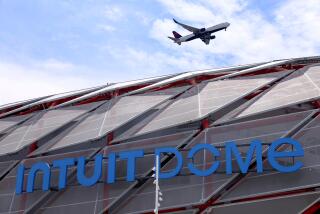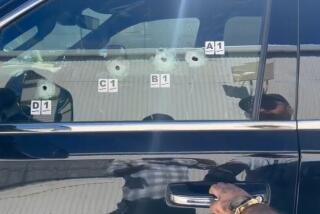Capitol Gang-Up : Sacramento Officials, Long Eager to Spotlight City, Are Less Than Thrilled With Latest Cause for Attention--the Unabomber Trial
- Share via
SACRAMENTO — For years, this burgeoning city of leafy neighborhoods and long-winded politicians has been striving for recognition as a big-time metropolis.
In the mid-’80s, the city’s leaders thought they struck it rich when they landed the NBA Kings, only to see the pro basketball team struggle through successive losing seasons.
Eager to be more than the capital of the nation’s largest state, the city offered Al Davis $50 million to bring his NFL Raiders, but the football team’s boss spurned the offer, leaving souvenir vendors to market “Sacramento Raiders” shirts as collectors items.
More recent, Mayor Joe Serna has renewed efforts to revive downtown by calling for the construction of a major league stadium and, perhaps, persuading the Oakland A’s to pack up and move 90 miles up Interstate 80.
But all that may pale for a time in the prolonged glare of the national spotlight soon to shine on the capital city. Unabomber suspect Theodore J. Kaczynski has come to town, followed by media from all corners of the country. And before long, the landmarks and skyline of the state’s seventh-largest city are likely to be spotted in the background on television screens from Europe to Asia.
City Hall is finding all the fuss as enjoyable as the Sacramento River running at flood stage. Michael Picker, an aide to the mayor, dismisses questions linking the city to the trial, saying the case of the alleged serial bomber is nothing special.
“From our perspective, it’s just another murder trial,” Picker said. “And it’s about a commuter killer, and it’s hard for us to believe it’s about Sacramento.”
Of course, it isn’t about the city where two fatal Unabomber attacks took place. But it’s not just another murder trial either.
If there were any doubts about that, they were dispelled when Kaczynski was flown from Helena, Mont., to Sacramento in a sleek, white U.S. marshal’s corporate-style jet that landed at a local Air Force base.
Under the kind of security usually reserved for the president, the former UC Berkeley math professor was ushered into a waiting bulletproof black Chevrolet Suburban and escorted to the county jail in a police motorcade consisting of several cars and motorcycles, and a helicopter.
When Kaczynski was moved from his cell for his arraignment a few blocks away at the federal courthouse, four machine-gun-toting marshals surrounded the vehicle.
Kaczynski is being held at the 1,800-inmate Sacramento County Jail, a much larger and more impersonal facility than his jail in Helena. His stay at the Lewis and Clark County Jail there apparently was agreeable.
He wrote a letter to the local newspaper thanking the jail staff “for their kindness and consideration.”
After Kaczynski pleaded not guilty June 25 to charges related to four bombing attacks, including the two Sacramento fatalities, a breathless local TV anchorwoman said the case was really putting the city on the map.
“This is a very big case for us as well,” said U.S. District Court Clerk Jack Wagner, who tried to juggle the demands of a throng of reporters, sketch artists and TV producers who descended on the courthouse to cover Kaczynski’s arraignment.
To be sure, the trial will not be the first time the city has been at the epicenter of national news. After gold was discovered near here in 1848, the town, first settled by John Sutter in 1839, was overrun by prospectors.
The river city that sprang up now boasts a population of 396,000 with a first-class state railroad museum, the restored state Capitol, a nationally acclaimed Dixieland festival, a top-notch art museum and a reputation as “the city of trees” because of its lush street foliage. To the delight of their many loyal fans this year, the Sacramento Kings reached the playoffs for only the second time.
And even before Kaczynski--who allegedly was drawn to some of Sacramento’s downtown hotels on bus trips from Montana--the city had its share of eye-catching criminal cases.
In 1993, Sacramento landlord Dorothea Montalvo Puente was found guilty of murdering three tenants for their government benefit checks and burying their bodies in the garden of her Victorian boardinghouse, which was home to elderly alcoholics and the mentally disabled.
In 1975, Charles Manson cultist Lynette “Squeaky” Fromme was found guilty in federal court of attempting to assassinate then-President Gerald Ford as he walked through Sacramento’s Capitol Park.
But in the ensuing two decades, the technology of news coverage has changed dramatically--as highlighted by the dozens of satellite TV trucks parked across from the courthouse to beam drawings of Kaczynski and his lawyers to stations nationwide.
City officials may frown at the potential for the trial to pull in tourist dollars. But one laid-off former Republican legislative staffer says he is poised to produce Kaczynski T-shirts.
The prospect of making money on the trial has not been lost either on a local hotel, which is offering special rates for out-of-town reporters, complete with shuttle service to the courthouse.
“Journalists will be given complimentary ‘Plaza Club’ privileges, which include daily continental breakfast, snacks, beverages and hosted reception,” according to an announcement by the Radisson Hotel.
When Kaczynski was arraigned, the hotel was sold out and had to turn away reporters, said Cherie Piper, the hotel’s director of sales and marketing.
News crews also were turned away from the eight-story Sacramento Unified School District headquarters next to the courthouse. TV stations sought to use the building to film Kaczynski’s comings and goings.
But George Medovoy, the school district’s communications director, said the appeals were rejected, adding that the TV cameras would have turned the building “into a kind of zoo.”
More to Read
Get the L.A. Times Politics newsletter
Deeply reported insights into legislation, politics and policy from Sacramento, Washington and beyond. In your inbox twice per week.
You may occasionally receive promotional content from the Los Angeles Times.










